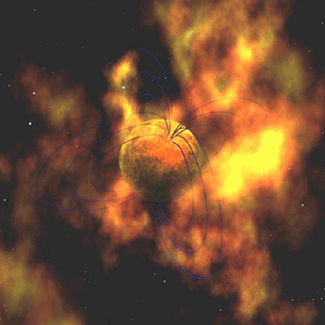Astronomers believe that highly magnetic neutron stars - known as magnetars - could be the driving force behind a little-understood group of pulsars. 'Anomalous x-ray pulsars', as they are known, earn their name because scientists are unsure what fuels their potent x-ray emissions. Now Marten van Kerkwijk of the University of Utrecht in the Netherlands and co-workers have inspected one of these unusual objects and believe its emissions are fuelled by a nearby magnetar (F Hulleman et al 2000 Nature 408 689).

Pulsars are rotating neutron stars that emit radiation, which is seen from Earth as a series of highly regular pulses. Anomalous x-ray pulsars (AXPs) are not, however, powered like most pulsars. AXPs do not appear to have companion stars from which they can gather material and energy to transform into x-ray emissions, and their x-ray output cannot be explained by a loss of rotational energy as they slow down. That leaves two possibilities. An AXP could gain energy by collecting matter from the accretion disc created by the supernova from which it was born. X-rays emitted by the AXP would be absorbed by the accretion disc and re-emitted as visible light. Alternatively, AXPs could be powered by the intense magnetic field of a neighbouring magnetar – a neutron star with a magnetic field around 1015 times greater than that of the Earth.
The Dutch-American group observed the visible light from an AXP labelled 4U0142+61 – the brightest AXP, in terms of x-ray emission – using the Keck telescopes on Mauna Kea in Hawaii. They found a faint star-like object at the same location as the x-ray source – it appears to be in the same place because the resolution of the telescope is not high enough to separate the AXP and any companion.
Van Kerkwijk and co-workers believe that the object is a magnetar because it is too faint to be an accretion disc and too small to be an ordinary star. Further analyses of the emission spectra ruled out the possibilities of a compact binary system and a companion hot white dwarf. If the object is a magnetar, its powerful magnetic field could easily fuel the AXP. “We believe the x-ray emission we are seeing is due to the decay of the magnetar’s very strong magnetic field”, van Kerkwijk told PhysicsWeb. “The magnetic field needs to be much stronger than the field of an ordinary neutron star to produce x-rays at all, but also to initiate the processes that cause the field to decay in the first place”.



